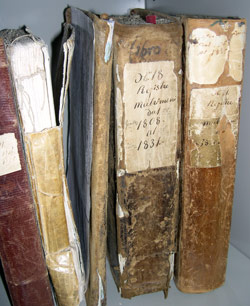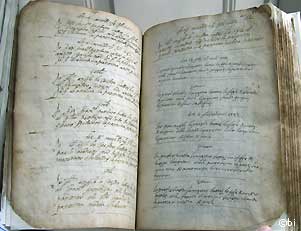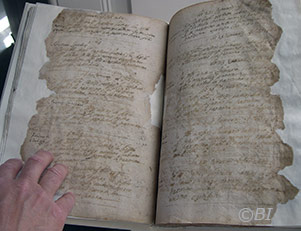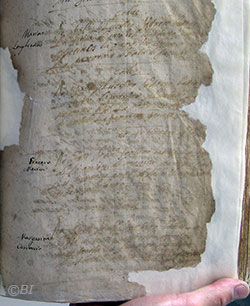 When thereafter was ordered to note down on the register the contracted marriage with the indication of wife or husband, father of wife or husband, date and locality, then thing can get very complicated. When thereafter was ordered to note down on the register the contracted marriage with the indication of wife or husband, father of wife or husband, date and locality, then thing can get very complicated.
Who is writing the note, first he'll have to find the space where to write, and writing small text with the goose quill of that time you can imagine what will happen. Often unreadable notes, smudges and corrections, faded or too heavy sepia ink. It is easy also to run into duplicates with different dates. The aforesaid baptism act is repeated to N° 576 this time correctly and so as Placido Gangi. The register was periodically controlled and endorsed by the appointed archpriest, otherwise was complete chaos. The acts numbering usually starts on the first day of every year and ends the 31st of December. On the register n° 4 the 2nd January 1816 the numbering does not starts from 1, but continues with 436, and goes on this way until the 12th f December 1836 when, once reached n° 1000, it is decided to start again from n°1. From this moment starts the chaos in the acts numbering. The numbers go back and forth. In 1848 from the number 627 of the 13th of May it goes to n°228 of the same month, and then goes on to the end of 1848. From that date the same system is used up to the last page of the register. Often, for a copyist to write Luca or De Luca was the same. For this reason drags on the hoary question if the Cardinal's surname was De Luca and not Luca while the De would have been added «to ennoble the family». Actually the marriage certificate of the cardinal's parents, in the marriages register n°16 of 1777-1790 to page 37 act n°46, about Vincentius De Luca reads as follows: «Eodem die 10 7bris 1780, …Ego sac D. Antoninus Luca ex lic. Parrocchi Antonius filius M.i Vincenti, e Agata Luca inn. N. Giusti Brontis ann: 28 cig. Et Francisca filia Sebastiani et Maria Saitta inn….anni 19 gig. In comunis Brontis ac im majori Parrocchiali Ecc.a Matrice SS. Triadis Interrogavi ... M.o Thomas Luca et m.o Litterio Politi:…». This shows that the name was written indifferently both ways. In consequence 99% of times the name was written as Luca.
Registers and social organization
 The Main Church registers reflect and give a precise idea of Bronte's society, that remained almost unchanged until the end of the second world war. The Main Church registers reflect and give a precise idea of Bronte's society, that remained almost unchanged until the end of the second world war.
In the Fifties, the external influx, the migrations between north and south in Italy or Europe caused the collapse of patriarchal society and the start of a new social order. From such registers becomes also evident that Bronte's population was divided in three sections: a middle class of landowners, wealthy and bunged in itself, an active artisan's class and an outcast class or "junnatari" which lived "from day to day" working for the others and trying so to make ends meet as much as they could. -- The Landowners middle class was represented by the few families who retained economic and social power. On the registers are always indicated as "Don" or "Donna": Cimbali, Luca, subsequently became De Luca, Spitaleri, became Spedalieri or Spetalieri, Radice, Meli, Artale, Grisley, Thovez, Fiorini, Fernandez, Aidala, Catania, Longhitano, Sanfilippo, Leanza, Margaglio, Turco or Lo Turco, Zappia, Torretta, Palermo, Cannata, Cesare, Biuso, Colavecchia ecc.. The marriages and christenings happen within similar families for wealth and respect within the Community. -- Members of entrepreneur crafts made are indicated as "Mastro" or "Maestro", and only when they have reached a certain social level shall be indicated as Don or Donna. To cite as proof the: Barbaria, Lupo, Aidala, Gorgone, Sofia, Camuto, Portaro, Di Bella, Samperi, Pannucci; -- Small landowners, merchants and workmen didn't get any title. -- The last social class was represented by the people without particular merits whose members were often indicated ad "quilibet". -- Women, finally, did not have any legal status. They existed only as "uxor", "soror", "mater", "filia", nephew of a man. Often instead of a surname there is the aforesaid indication. If she is the godmother in a christening, is indicated with her surname only if "quilibet" and cannot adorn herself with the "uxor" title. This is why my research work had to stop around year 1760, as, without the possibility of finding the wife surname. I find difficult to link the various families trying to create a genealogic tree. Maybe in the near future, when this first part shall be completed, I shall try to go beyond this date.
Surnames and families, errors and anomalies
 As a proof of what has been said so far and that anything can be said about filing clerks except that they knew how to write, hereon I shall show some examples of anomalies or mistakes found in the registers about surnames. As a proof of what has been said so far and that anything can be said about filing clerks except that they knew how to write, hereon I shall show some examples of anomalies or mistakes found in the registers about surnames.
The surname Aricò is written as: Aliquò, Ariquò, Tricò, so in the family Franzone-Aricò, every son has a different surname. Bandieramonte Sebastiano born in Trecastagni and married in Bronte, is written Ballaramonte for his daughter Ballaramonte Domenica Giuseppa Rosolia born the 3/04/1823. (Reg. 2, p. 22, act 136). The surname Basile, around 1820-1830, is written sometime Di Basile, some others Basile. In the following years simply Basile. The surname Batticani, also because of the dialect, sometime is written "Batticane", in italian. Calcagno sometime is written "Carcagno" and other times "Calvagno" while Cariola appears as Caliora or Cariola Placido. The surname Chiofalo was written "Chiofaro" around year 1780. Daquino started to be written with an apostrophe (D'Aquino) in 1852 with D'Aquino Vincenzo, son of D'Aquino Pasquale and Milazzotto in the Volume 20 (86) of the marriages registers, and at the same time on the baptisms registers. With the appointment as Archpriest of Don Salvatore Politi (1859), learned priest and Latinist, compiler of the diary of Bronte's Facts found in the registers and copied elsewhere, and with the coming of Italy's Unify, starts a tendency to Italianize surnames and get close to today's writing through a series of distortions and surnames multiplications derivate from a unique original. Even the surname Di Bella, around the years 1820-1830, appeard on the registers as "Bella" or "La Bella". In subsequent years was written as the current Di Bella.  The sons of Di Marco Giuseppe married to Maccarrone Vincenza are registered once as Di Marco and then as Di Marzo, while the sons of Di Marzo Giuseppe married to Camano Ignazia did not undergo any change. From this moment (1828-31) all the Di Marco disappear and become Di Marzo. The sons of Di Marco Giuseppe married to Maccarrone Vincenza are registered once as Di Marco and then as Di Marzo, while the sons of Di Marzo Giuseppe married to Camano Ignazia did not undergo any change. From this moment (1828-31) all the Di Marco disappear and become Di Marzo.
The surname Fazzio, is written with one or two "z" and often becomes Di Fazio. The surname of Gardano Giuseppe, from Randazzo is written Ganduni, Cardani. The Grisley family's members: They arrive to Bronte from London in the first years of the 18th century, the father, Samuel Grisley, the mother, Marta Grisley and the son Vincent Samuel that was chastened "sub conditione" the first of October 1820, doubting he could have been an Anglican. This surname was copied in various ways from then on (Grijlech, Gryslech, Grisleus). The surname Lo Turco was regularly cut to Turco by the copyists, an habit which was transmitted to the Bronte's citizens who try to shorten and adapt the surnames to their dialect.
We find an evident example of this in the page 30 (119) of the volume n°4 where it is registered the christening's act Turco Illuminata daughter of Don Ignazio Lo Turco and Donna Anna Lo Turco. For their son Mariano, born the 2nd of April 1841, the "Lo" disappears, and so does also for his father Don Ignazio Turco, mother Donna Anna Turco and his sister Nunzia born the 13th of February 1836. From there on the Lo Turbo family becomes "Turco" in every baptism certificate because for the copyist writing Turco or Lo Turco was the same. The surname Luca follows the same pattern, is written indifferently Luca, Di Luca, De Luca. The De Luca family had to ask a competent court to unify the surname within the "Clan". The surname Monciovì or Mongiovì derives the transformation of the surname Monciout of mister Leonardo who, coming from Palermo, marries miss Saporito Serafina. Their son born the 14th of March 1819 is Monciovì Giacomo Antonino Giuseppe. So registered on the Vol. 1 (29) – p. 347 Act 134. The surname Pace, is often written "Di Pace", "Pace", "Paci", depending on the writing abilities of the copyist. Pettinato, one of the most graphically stable surnames, in the case of the Capuchin Don Luigi Pettinato, around 1784, is often written "Pettinati". Another problem of surname's Italianization can be seen with the surname "Prazzamà", so copied in the register 4 of the 4/10/1840 for Placida Prazzamà of Prazzamà Felice; in the same register her sister Giuseppa, the 2nd of August 1846 is indicated as Giuseppa Bracciamà of Bracciamà Felice. The surname Proto ensues from the contraction of Protos. That is why we find a Protos Giuseppe born the first of March 1829 son of Protos Tommaso and Modica Anna Maria. The surname Radice, around 1780 was written also "Radicia" as it appears in the case of the priest don Antonino Radice (1784) and many other surnames got the same treatment by the fantasy or the incompetence of the various copyists. Nunzio Longhitano 21st of June 2007
|